MENU
The Electronic Scholarly Publishing Project: Providing access to classic scientific papers and other scholarly materials, since 1993. More About: ESP | OUR CONTENT | THIS WEBSITE | WHAT'S NEW | WHAT'S HOT
Comparative Timelines
The ESP Timeline (one of the site's most popular features) has been completely updated to allow the user to select (using the timeline controls above each column) different topics for the left and right sides of the display.
Select:
New Left Column
New Left Column
Dates
Decade
New Right Column
New Right Column
(no entry for this year)
1850
(no entry for this year)
 The fast-acting Collodion process invented by Frederick Scott Archer. Images require only two or three seconds of light exposure. Collodion process, mostly synonymous with the "collodion wet plate process", requires the photographic material to be coated, sensitized, exposed and developed within the span of about fifteen minutes, necessitating a portable darkroom for use in the field. Collodion is normally used in its wet form, but can also be used in humid ("preserved") or dry form, at the cost of greatly increased exposure time. The latter made the dry form unsuitable for the usual portraiture work of most professional photographers of the 19th century. The use of the dry form was therefore mostly confined to landscape photography and other special applications where minutes-long exposure times were tolerable.
The fast-acting Collodion process invented by Frederick Scott Archer. Images require only two or three seconds of light exposure. Collodion process, mostly synonymous with the "collodion wet plate process", requires the photographic material to be coated, sensitized, exposed and developed within the span of about fifteen minutes, necessitating a portable darkroom for use in the field. Collodion is normally used in its wet form, but can also be used in humid ("preserved") or dry form, at the cost of greatly increased exposure time. The latter made the dry form unsuitable for the usual portraiture work of most professional photographers of the 19th century. The use of the dry form was therefore mostly confined to landscape photography and other special applications where minutes-long exposure times were tolerable.
1851
(no entry for this year)
(no entry for this year)
1852
(no entry for this year)
(no entry for this year)
1853
(no entry for this year)
 André-Adolphe-Eugène Disdéri credited with introduction of the carte de visite (English: visiting card or calling card) format for portraiture. Disdéri uses a camera with multiple lenses that can photograph eight different poses on one large negative. After printing on albumen paper, the images are cut apart and glued to calling-card-size mounts. Photographs had previously served as calling cards, but Disdéri's invention of the paper carte de visite (i.e. "visiting card") enabled the mass production of photographs. On 27 November 1854 he patented the system of printing ten photographs on a single sheet (although there is no evidence that a system printing more than eight actually materialized). Disdéri's's cartes de visite were 6×9 cm, about the size of conventional (nonphotographic) visiting cards of the time, and were made by a camera with four lenses and a sliding plate holder; a design inspired by the stereoscopic cameras. The novelty quickly spread throughout the world. According to a German visitor, Disdéri's studio became "really the Temple of Photography - a place unique in its luxury and elegance. Daily he sells three to four thousand francs worth of portraits". The fact that these photos could be reproduced inexpensively and in great quantity brought about the decline of the daguerreotype and ushered in a carte de visite craze as they became enormously popular throughout Europe and the United States. Disdéri also invented the twin-lens reflex camera.
André-Adolphe-Eugène Disdéri credited with introduction of the carte de visite (English: visiting card or calling card) format for portraiture. Disdéri uses a camera with multiple lenses that can photograph eight different poses on one large negative. After printing on albumen paper, the images are cut apart and glued to calling-card-size mounts. Photographs had previously served as calling cards, but Disdéri's invention of the paper carte de visite (i.e. "visiting card") enabled the mass production of photographs. On 27 November 1854 he patented the system of printing ten photographs on a single sheet (although there is no evidence that a system printing more than eight actually materialized). Disdéri's's cartes de visite were 6×9 cm, about the size of conventional (nonphotographic) visiting cards of the time, and were made by a camera with four lenses and a sliding plate holder; a design inspired by the stereoscopic cameras. The novelty quickly spread throughout the world. According to a German visitor, Disdéri's studio became "really the Temple of Photography - a place unique in its luxury and elegance. Daily he sells three to four thousand francs worth of portraits". The fact that these photos could be reproduced inexpensively and in great quantity brought about the decline of the daguerreotype and ushered in a carte de visite craze as they became enormously popular throughout Europe and the United States. Disdéri also invented the twin-lens reflex camera.
1854
(no entry for this year)
(no entry for this year)
1855
 Alfred Russel Wallace publishes "On the Law which has Regulated the Introduction of New Species," anticipating Darwin's theory of evolution by natural selection.
Alfred Russel Wallace publishes "On the Law which has Regulated the Introduction of New Species," anticipating Darwin's theory of evolution by natural selection.
(no entry for this year)
1856
 The remains of the first known example of what come to be known as the "Neanderthals" is found in a cave near Düsseldorf, in the Neander Valley. The discovery was made by limestone quarry miners and consists of a skullcap, two femora, the three right arm bones, two of the left arm bones, ilium, and fragments of a scapula and ribs. The fossils were given to Johann Carl Fuhlrott, a local teacher and amateur naturalist. The first description of the remains was made by anatomist Hermann Schaaffhausen and the find was announced jointly in 1857.In 1997, the specimen was the first to yield Neanderthal mitochondrial DNA fragments. The description of this discovery represents the beginning of paleoanthropology as a scientific discipline.
The remains of the first known example of what come to be known as the "Neanderthals" is found in a cave near Düsseldorf, in the Neander Valley. The discovery was made by limestone quarry miners and consists of a skullcap, two femora, the three right arm bones, two of the left arm bones, ilium, and fragments of a scapula and ribs. The fossils were given to Johann Carl Fuhlrott, a local teacher and amateur naturalist. The first description of the remains was made by anatomist Hermann Schaaffhausen and the find was announced jointly in 1857.In 1997, the specimen was the first to yield Neanderthal mitochondrial DNA fragments. The description of this discovery represents the beginning of paleoanthropology as a scientific discipline.
Louis Agassiz publishes Essay on Classification advocating a theory of multiple creations and contradicting both evolution and Noah's ark.
(no entry for this year)
1857
(no entry for this year)
(no entry for this year)
1858
 Alfred Russel Wallace sends to Darwin a manuscript — "On the Tendency of Varieties to Depart Indefinitely from the Original Type" — that shows clearly that Wallace has independently formulated a model of evolution by natural selection.
Alfred Russel Wallace sends to Darwin a manuscript — "On the Tendency of Varieties to Depart Indefinitely from the Original Type" — that shows clearly that Wallace has independently formulated a model of evolution by natural selection.

 Darwin's and Wallace's ideas are jointly presented to the Linnaean Society of London.
Darwin's and Wallace's ideas are jointly presented to the Linnaean Society of London.
ESP Quick Facts
ESP Origins
In the early 1990's, Robert Robbins was a faculty member at Johns Hopkins, where he directed the informatics core of GDB — the human gene-mapping database of the international human genome project. To share papers with colleagues around the world, he set up a small paper-sharing section on his personal web page. This small project evolved into The Electronic Scholarly Publishing Project.
ESP Support
In 1995, Robbins became the VP/IT of the Fred Hutchinson Cancer Research Center in Seattle, WA. Soon after arriving in Seattle, Robbins secured funding, through the ELSI component of the US Human Genome Project, to create the original ESP.ORG web site, with the formal goal of providing free, world-wide access to the literature of classical genetics.
ESP Rationale
Although the methods of molecular biology can seem almost magical to the uninitiated, the original techniques of classical genetics are readily appreciated by one and all: cross individuals that differ in some inherited trait, collect all of the progeny, score their attributes, and propose mechanisms to explain the patterns of inheritance observed.
ESP Goal
In reading the early works of classical genetics, one is drawn, almost inexorably, into ever more complex models, until molecular explanations begin to seem both necessary and natural. At that point, the tools for understanding genome research are at hand. Assisting readers reach this point was the original goal of The Electronic Scholarly Publishing Project.
ESP Usage
Usage of the site grew rapidly and has remained high. Faculty began to use the site for their assigned readings. Other on-line publishers, ranging from The New York Times to Nature referenced ESP materials in their own publications. Nobel laureates (e.g., Joshua Lederberg) regularly used the site and even wrote to suggest changes and improvements.
ESP Content
When the site began, no journals were making their early content available in digital format. As a result, ESP was obliged to digitize classic literature before it could be made available. For many important papers — such as Mendel's original paper or the first genetic map — ESP had to produce entirely new typeset versions of the works, if they were to be available in a high-quality format.
ESP Help
Early support from the DOE component of the Human Genome Project was critically important for getting the ESP project on a firm foundation. Since that funding ended (nearly 20 years ago), the project has been operated as a purely volunteer effort. Anyone wishing to assist in these efforts should send an email to Robbins.
ESP Plans
With the development of methods for adding typeset side notes to PDF files, the ESP project now plans to add annotated versions of some classical papers to its holdings. We also plan to add new reference and pedagogical material. We have already started providing regularly updated, comprehensive bibliographies to the ESP.ORG site.
ESP Picks from Around the Web (updated 06 MAR 2017 )
Old Science

Weird Science

Treating Disease with Fecal Transplantation
Fossils of miniature humans (hobbits) discovered in Indonesia

Dinosaur tail, complete with feathers, found preserved in amber.
Astronomy

Mysterious fast radio burst (FRB) detected in the distant universe.